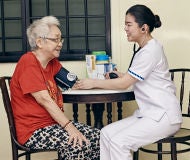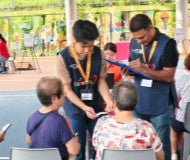Singapore General Hospital will NEVER ask you to transfer money over a call. If in doubt, call the 24/7 ScamShield helpline at 1799, or visit the ScamShield website at www.scamshield.gov.sg.
We’d love to hear from you! Rate the SGH website and share your feedback so we can enhance your online experience and serve you better. Click here to rate us
Walking with the Nation

The story of SGH mirrors historical events in Singapore. While providing public healthcare has always been its core function, it has always responded to support the nation during its moments of great need and crisis.
In the tumultuous years leading up to independence in 1965, Singapore experienced unrest such as the Maria Hertogh race riots, Hock Lee Bus strike and riots and Konfrontasi (or Confrontation) with Indonesia, which conducted military operations in Singapore and Malaysia, in objection to the formation of Malaysia. SGH treated the victims from these incidents which resulted in deaths and injuries.
The hospital also took on the urgent task of conducting mandatory medical checks on new recruits for the nascent National Service, when compulsory conscription of male youths was introduced to quickly build Singapore’s defence force.
As the nation’s flagship hospital, SGH has always played an important role in responding to mass casualty incidents, national and regional disasters. Its Emergency Department had just opened in 1977, when it saw victims from the Spyros oil tanker explosion in 1978. It also managed the trauma victims from the Hotel New World building collapse in 1986. SGH has also constantly played a humanitarian role in the region such as responding to the Indian Ocean Tsunami in 2004.
The Hospital’s record is an important one within the wider context of the history of medical services in Singapore. Its development has been in tandem with the social, economic and political changes that have taken place through the years. The advances and improvements in medical care through the decades …can be even more highly appreciated when viewed against the backdrop of untold struggles with inadequate funds, manpower, facilities and equipment. That SGH has always overcome adversities and obstacles is reflective of the character and resilience of the institution. This in turn is testament of the devotion, dedication and tenacity of its people.

Dr Kwa Soon Bee
Permanent Secretary for Health (1984-1996) & Superintendent, Medical Services, SGH (1972)
Extracted from his reflections in The First General Hospital, a publication on the 175th anniversary of SGH
Battle with COVID-19
Covid-19 pandemic brought on unprecedented onslaughts, not just for SGH, but for healthcare globally. SGH swiftly established a COVID19 Taskforce to direct hospital attempts to contain the infection.
Read about our fight against COVID19
Caring for founding Prime Minister Lee Kuan Yew
On the 5th of Feb 2015, Lee Kuan Yew was admitted into the Singapore General Hospital for severe pneumonia.
Read about our role in caring for Prime Minister Lee
Responding to Civil Emergencies
The collapse Hotel New World in 1986 was Singapore’s worst civil disaster since the Spyros explosion. Thirty-three people died and 17 were rescued in the five-day inter-agency search and rescue.
Read about the story behind SGH Emergency Department
Fire & Burns
SGH has always played an important role in responding to mass casualty incidents and national disasters. SGH built on the experience to establish the SGH Burns Centre to become a centre of excellence that serves patients not just from Singapore but countries in the surrounding region.
Read about the story behind SGH Burns Centre
The Japanese occupation forces took over the General Hospital for use by their troops in Southeast Asia. However, the disruption from the war brought about a paradigm shift in the local medical community. With the expatriate doctors interned by the Japanese during the war, local doctors and staff as
Just five years after gaining independence, Singapore was actively exploring avenues of economic development to ensure its sustainability. Initiatives were underway to make Singapore a liveable city, and healthcare systems and services had to keep pace with modern advances advances across the globe
SGH has undergone numerous transformations since its establishment nearly 200 years ago to keep up with the needs of Singaporeans. The iconic Bowyer Block, a National Monument in recognition of its national significance and rich history, is a standing reminder of how far we have come in advancing
Stay Healthy With
Outram Road, Singapore 169608
© 2025 SingHealth Group. All Rights Reserved.



















